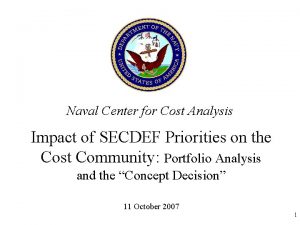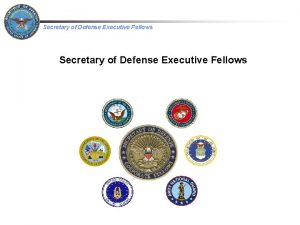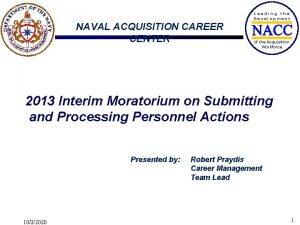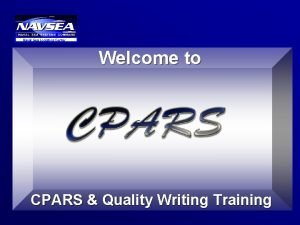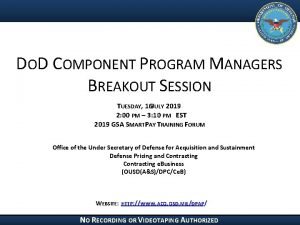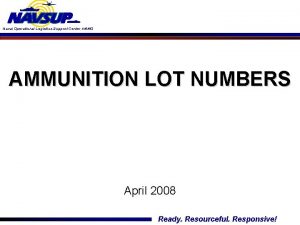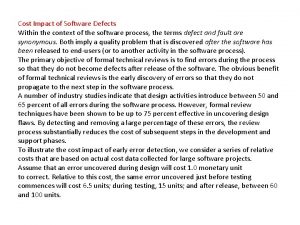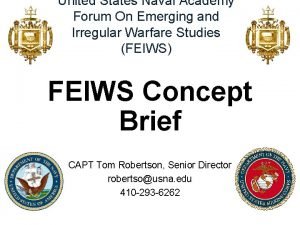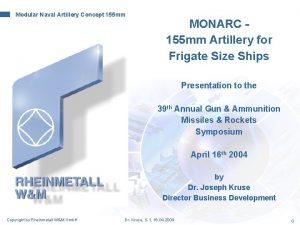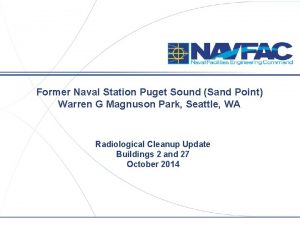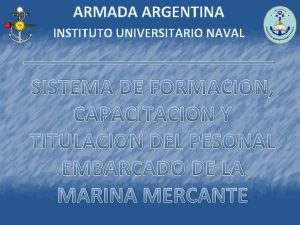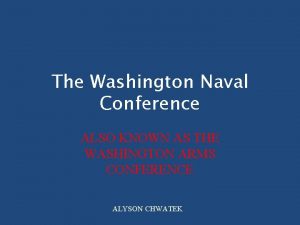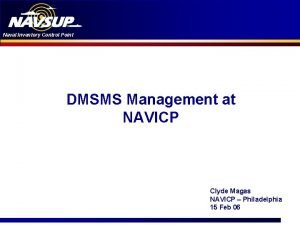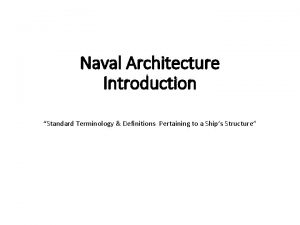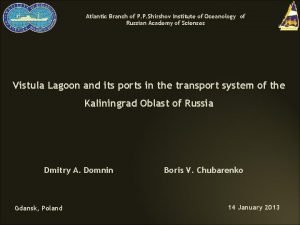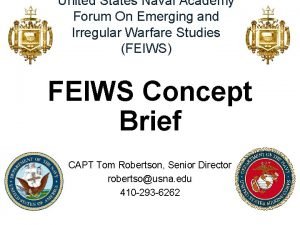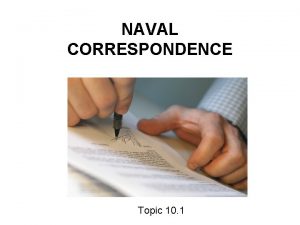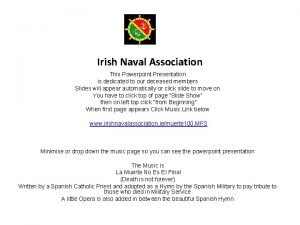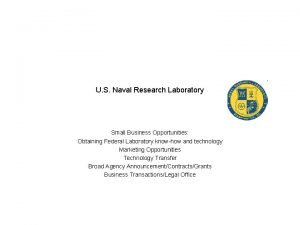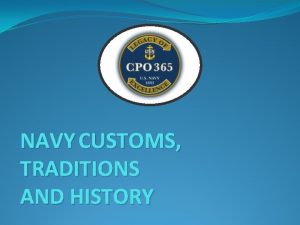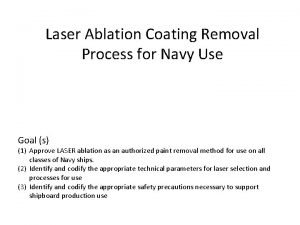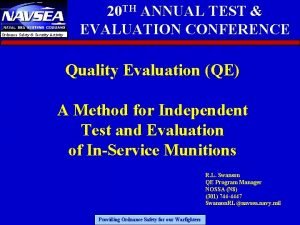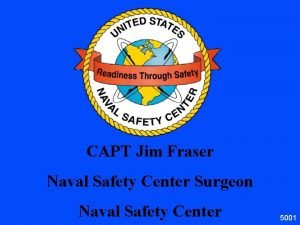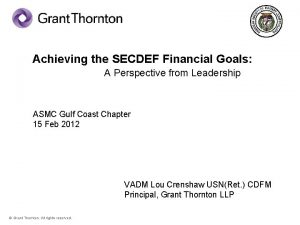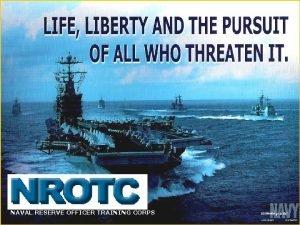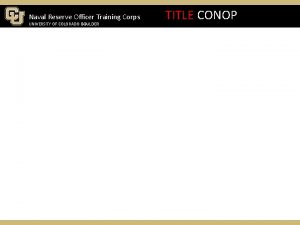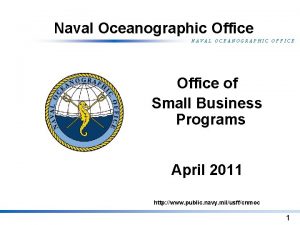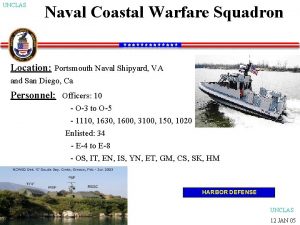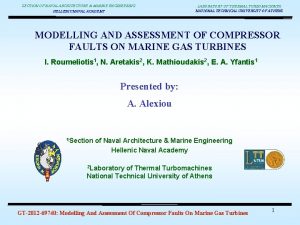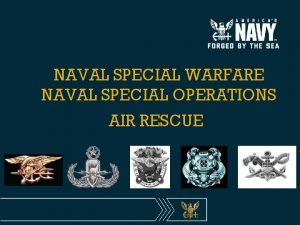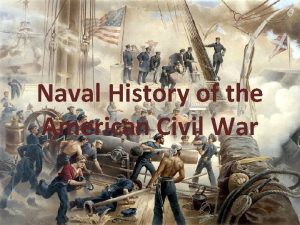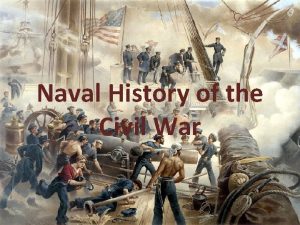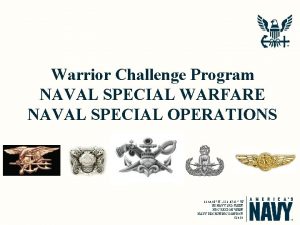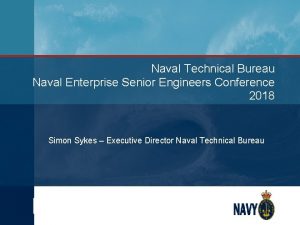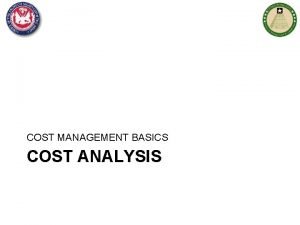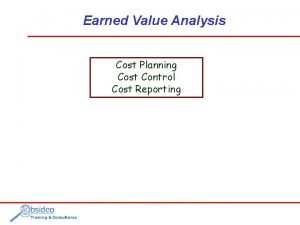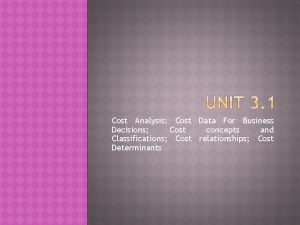Naval Center for Cost Analysis Impact of SECDEF


































- Slides: 34

Naval Center for Cost Analysis Impact of SECDEF Priorities on the Cost Community: Portfolio Analysis and the “Concept Decision” 11 October 2007 1

Contents • Introduction • Navy Pilot Portfolio Analysis Effort – Capabilities, costs, and risks – Results • Do. D Transformation Priorities – New strategic planning process • Concept Decision • Capability portfolio management • Implications for the Do. D cost community – Requirement – Approach NCCA 2

Definition • Portfolio analysis is a decision-support process for allocating scarce resources to satisfy strategic goals – “A dynamic decision process” – “A resource allocation process” – “Manifestation of a business’s strategy” • In a national security setting, this decision-support process needs to – Support all of SECDEF’s national strategic requirements – Consider costs, capabilities, and risks of all assets in a war fighting area NCCA 3

Literature Review • Literature review and model search – Do. D components and defense firms – Journal articles – Academic and Wall Street subject matter experts • Insights – Many international companies attempt portfolio analysis – Most existing Do. D models fall short • Ao. As and campaign analyses portfolio analysis • Other models/processes consider only a subset of tasks, costs, and capabilities • One exception is US Special Operations Command’s (SOCOM’s) strategy-to-task assessment model – But SOCOM is not in the business of major weapon system acquisition NCCA 4

Background Environment • Uncertain and changing information • Dynamic opportunities • Multiple goals and strategic considerations • Interdependence among projects • Multiple decision-makers and locations NCCA Goals • Value optimization – Return on investment • Balance – – Short-term versus long-term High-risk versus low-risk Across product categories Basic research vs production • Strategic direction – “On-strategy” 5

Background Common Problems • Portfolios do not reflect strategy • Poor overall quality – New projects weak or mediocre • Lack of focus – Resources wasted on the wrong projects • “Tunnels, not funnels” • Trivialization of product development NCCA Best Practices • No magic solution • Best practitioners – Use an average of 2. 4 techniques (e. g. , visual & scoring models) – Use a risk-reward bubble diagram – Emphasize strategy, strategy 6

Expected Commercial Value NCCA 7

Risk-Reward Bubble Diagram NCCA 8

Approach for Do. D • Private sector projects future costs and income flows, as well as risk – Models and subject matter experts (SMEs) employed • SMEs used to assess strategic importance and risk • In Do. D, we need to project future costs and capability flows, as well as risk – SMEs needed to assess • Importance of strategic, operational, and tactical tasks • Value of systems and platforms • Risk NCCA 9

Expected Military Value Sample Theoretical Construct at a National Security Level (One of Many Possibilities) Expected Military Value EMV = [(SI + DC) *(Pts; Pos) ] possibilities SI = Strategic importance of project DC = Degree of capability achieved Pts = Probability of technical success Pos =Probability of operational success Strategic Objectives 1. Secure US from direct attack 2. Secure strategic access & retain global freedom of action 3. Strengthen alliances & partnerships 4. Establish favorable security conditions Key Operational Capabilities 1. Strengthen intelligence 2. Protect critical bases of operation 3. Operate from the commons (sea, air, space, cyberspace) 4. Project & sustain forces in distant anti-access areas 5. Deny enemies sanctuary 6. Conduct network-centric operations 7. Improve proficiency against irregular challenges 8. Increase capabilities of partners NCCA National Defense Strategy (1 Mar 05) 10

Pilot Program • Purpose – Designed to test proof of concept • Selection of portfolio – Mine Countermeasure (MCM) assets • Endorsed by ASN(FM&C) and the Assistant Commandant of the Marine Corps • Sufficiently complex in detail to maximize lessons learned for later application to “bigger Navy” – Many individual systems – Multi-purpose platforms NCCA 11

Mission of MCM • Maintain “…a credible offensive sea mining capability for strategic deterrence and force protection” • Provide “…mine countermeasure assets … to ensure … the free movement of U. S. … forces” – All maritime forces including Marine Corps units and logistics transport (commercial shipping and Military Sealift Command) – From harbors to sea lanes to logistics unloading areas to high-water mark on landing beaches NCCA 12

Threat • Multiple potential enemies – 50 countries now posses sea mines – Terrorist groups • Unregulated, international market – Mines designed, built, and sold by our friends and potential foes alike • Asymmetric force multiplier – Low cost (e. g. , $1, 500 Iranian contact mine damaged FFG-58 Samuel B. Roberts in 1988) – Sophistication, reliability, & lethality increasing rapidly • Stealth technology (irregular shapes, plastic) • Remotely controlled • Improved sensors and propulsion systems NCCA 13

Threat • Asymmetric (a few examples of bottom-influence mines) – Sweden’s ROCKAN • Fiberglass case • Anechoic and nonferrous materials (to reduce acoustic and magnetic signatures) – Russia’s UDM • Remote control capability • Variant is the SMDM which includes a torpedo afterbody for standoff and increased-depth capability – China’s EM 55 • Buoyancy and rocket-propelled variants NCCA 14

MCM Portfolio NCCA 15

Design of the Scoring • Strategy-to-systems model for MCM assets Identification and Ranking of Strategic Tasks Weightings Operational to Strategic Tasks Weightings Tactical to Operational Tasks Weightings Systems to Tactical Tasks -- Effectiveness -- Risk Tied to National Defense Strategy and Presidential Directives NCCA 16

Scoring of Strategic Tasks NCCA Strategic Tasks Allocation/ Score 1. Protect Operating Forces Against the Threat of Sea Mines for Power Projection Ashore 15 2. Defend U. S. Ports and Coastal Approaches Against Sea Mines 50 3. Maintain Mobility of Operational Forces in Presence of Sea Mines 13 4. Collect, Analyze, and Share Intelligence Related to the Worldwide Threat of Sea Mines 10 5. Preserve Freedom of the Seas for Commercial Navigation in Presence of Sea Mines 12 Each scorer will allocate a total of 100 points among the five strategic tasks. This allows the scorers to both rank the tasks and give a relative importance between them. For instance, if 10 points are allocated to task #4 and 50 point are allocated to task #2, the scorer is saying that task #2 is 5 times as important as task #4. 17

Scoring Operational Tasks Tactical to operational tasks are linked the same way. NCCA 18

Cost Estimating Scope and Challenge NCCA Ground Rules & Approach 19

Value of Systems NCCA 20

Do. D Transformation Priorities • Briefed to President Bush on 7 August 2007 NCCA 21

Do. D Transformation Priorities • Two of the top five are to 1. “Establish a new strategic planning process to • • • Better prioritize and align resources to joint capability demands Implement a common, transparent decision framework Expand capability portfolio management 2. Pursue targeted acquisition reforms to • NCCA Use the Concept Decision [as a strategic choice]” 22

Concept Decision: As-Is Including the DAB, CAIG, and Cost Centers Lead Do. D Component designated NCCA 23

Concept Decision: To-Be Strategic Choice of Portfolio Options with Requirements, Acquisition, & Programming Stakeholders Represented Portfolio Analysis NCCA 24

Holistic View NCCA 25

Potential Payoff • Integrated investment decisions … – Focus on portfolios instead of single programs • Requirements, costs, capabilities, and risks – Focus on the Concept Decision • Point of strategic choice Fewer redundancies; greater system commonality; shared technologies; focus on joint warfighter • … made earlier in the decision process Shorter time to field needed warfighter capabilities, taking better advantage of S&T investments More efficient use of scarce defense resources; higher payoff to the taxpayer NCCA 26

DAWG Work NCCA 27

Methodology NCCA 28

Notional Example • Next two slides were briefed recently to DEPSECDEF, Vice Chairman JCS, and other members of the DAWG • Tentative foray into portfolio analysis, based on required capabilities to support a notional MCO or stability operation Unclassified, hypothetical scoring “In defense planning, capability is defined as the enduring ability to generate a desired operational outcome or effect, and is relative to the threat, physical environment, and contributions of coalition partners. ” [Through Life Capability Management Conference, London, 2007] NCCA 29

Slide available upon request NCCA 30

NCCA 31

Implications for Cost Community Capability/Life-Cycle Cost is the denominator ! Scope is a portfolio rather than a system ICEs remain a statutory requirement; some IDs could be delegated to Services Linkage required: cost community to planners New tools & techniques & additional headcount will be needed NCCA 32

Approach ● Develop new tools and techniques - Hedonistic regression - OR techniques to help planners - Leverage on DASA C&E effort ● Increase visibility & availability of data - Do. D-wide databases - Leverage on OSD CAIG effort ● Build libraries of cost for various portfolios such as undersea warfare - JCA re-baselining effort ● Establish links with AT&L and Joint Staff planners - Concept Decision Working Group ● Form OSD CAIG/Service working group ● Long term: institutionalize support of cost community (CJCSI 3170 & Do. DI 5000. 2) NCCA 33

Semper Fi "Among the men who fought on Iwo Jima, uncommon valor was a common virtue. " (Fleet Admiral Chester W. Nimitz, USN, 16 March 1945) NCCA 34
 Naval center for cost analysis
Naval center for cost analysis Secdef executive fellowship
Secdef executive fellowship Secretary of defense executive fellows program
Secretary of defense executive fellows program Naval acquisition career center
Naval acquisition career center Nswc pd
Nswc pd Naval sea logistics center
Naval sea logistics center Naval surface warfare center
Naval surface warfare center Naval operational logistics support center
Naval operational logistics support center Cost behavior patterns
Cost behavior patterns Cost of software defects
Cost of software defects War breaks out in europe
War breaks out in europe Naval academy forum
Naval academy forum Starboard and port side
Starboard and port side Monarc cannon
Monarc cannon Naval station puget sound
Naval station puget sound Combate
Combate Guia del combate naval de iquique
Guia del combate naval de iquique Poesia de arturo prat
Poesia de arturo prat Instituto universitario naval
Instituto universitario naval Washington naval conference purpose
Washington naval conference purpose Naval service training command
Naval service training command Navicp
Navicp Dra norma naval tucumán
Dra norma naval tucumán Adjective bank
Adjective bank Naval architecture terms
Naval architecture terms Russia naval base
Russia naval base Feiws
Feiws Naval correspondence manual
Naval correspondence manual Irish naval association
Irish naval association Naval manak
Naval manak Royal norwegian naval academy
Royal norwegian naval academy Naval customs and traditions
Naval customs and traditions Naval coating
Naval coating Naval ordnance safety and security activity
Naval ordnance safety and security activity James fraser naval aviator
James fraser naval aviator
